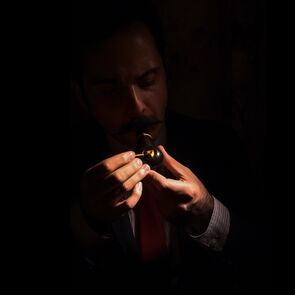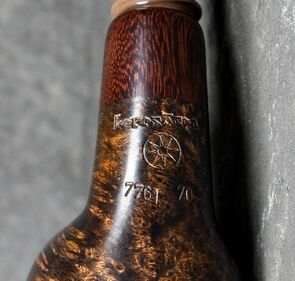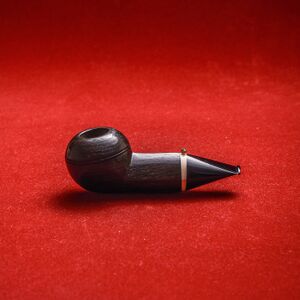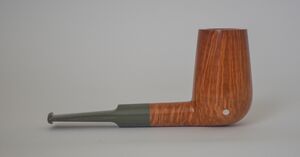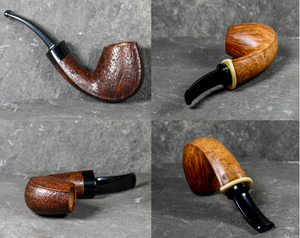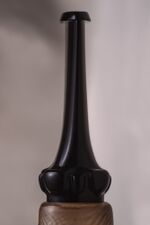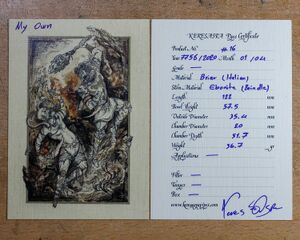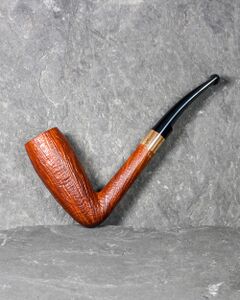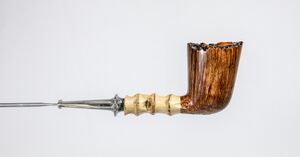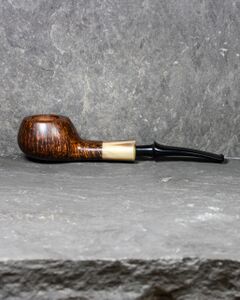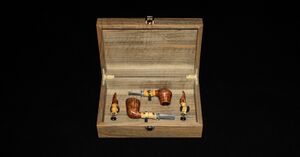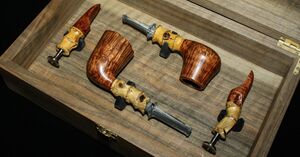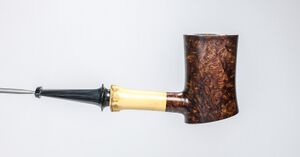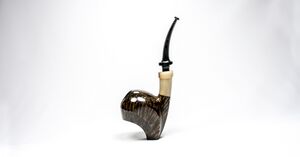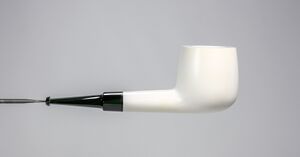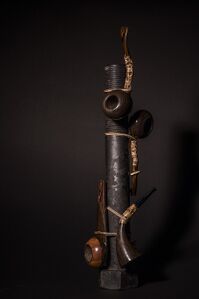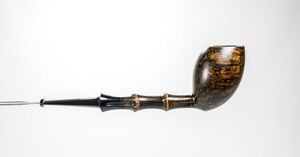Keresaspa
Keresaspa (Persian: گرشاسپ; IPA: Kərəsāspa) pipes are made by Saeed ‘Keresaspa’ Nazarli (b. 1991), an Iranian pipemaker living in Tehran. Keresaspa is the nickname that he goes by, and the name given to his pipes; it is a transliteration of the name of a an ancient Persian mythological figure, which is itself an Avestan word meaning ‘he with the slender horses.’ While there are clear Scandinavian influences in Kerasaspa pipes, both in their aesthetics and in their attention to the intricacies of function, there is a distinctive Persian aspect to their presentation, one that is likely to intrigue Western pipe smokers. It is not only the name 'Keresaspa' that has its origins in Middle-Eastern history and culture; the grades he assigns to his pipes - Ishtar, Shamash, and Seen - all denote deities or symbols from its antiquity; some of the design choices in his pipes are inspired by the architecture of the Achaemenid empire; Keresaspa pipes are dated using the Old Persian solar calendar; and the certificate that accompanies each of his pipes displays an elaborate rendition of one of the mythological battles of the Zoroastrian Avesta, and incorporates a script designed by an Iranian master calligrapher. Keresaspa lives with his wife, who also makes pipes under the Avestan name Atin.[1]
Keresaspa began smoking pipes in 2010 and soon began researching them as an enthusiast. He later co-founded the Iran Pipe Club, writing numerous articles about pipes and tobacco for the IPC and serving as its president between 2012 and 2018.
After graduating from high school, he enrolled in university to study chemical engineering, before switching to a course in architecture. When it came to pipes, Keresaspa was very interested in understanding the engineering behind what makes the mythical ‘perfect smoker,’ and in learning the difference between factory-made pipes and artisan pipes. He was fascinated by high-end pipes, especially those hand made by skilled artisans, but could not afford one for himself.
In 2015, he decided to start seriously researching the craft of pipemaking, and to collect the materials needed to experiment with pipemaking for himself. Over the course of the year, he gathered the materials he needed, and found a workshop that would rent him a lathe to use for a few hours a week. In 2016, he made his first pipe.
Keresaspa’s education in pipemaking came from reading as many articles on the subject as he could find, from magazines, books, and pipemaking forums on the internet. He also studied interviews with pipemakers and videos that showed these artisans and factory carvers demonstrating how pipes are made.
Using this information, he experimented with making his first pipes, concentrating first on their functional properties. These pipes were made for his own use, meaning Keresaspa was able to create several stems for the same stummel, making minor adjustments to the diameter of the draught hole or the funneling of the airway, before testing out how they affected the smoking qualities of the pipe. Keresaspa would also sometimes experiment with drilling and re-drilling the draught holes of his stummels, combining them with his variously measured stems, in order to discover the ideal combination of the two. To this day, Keresaspa considers the stem to be the most important part of the pipe, meaning he will spend several days only doing stem work until he is satisfied with the outcome.
In terms of influences, Keresaspa remains fascinated by the precise engineering behind the ‘perfect smoker.’ Therefore, a major influence upon Keresaspa’s pipes are the experiments he has undertaken in order to fine-tune the smoking characteristics of a pipe. In addition to this, Keresaspa asks his customers who own high-end artisan pipes to send him lists of their measurements, so that he has more variables to test out for himself. Keresaspa is also a great admirer of the aesthetic styles of many of the masters of Scandinavian and Japanese pipemaking, citing Sixten and Lars Ivarsson, Bo Nordh, Jørn Micke, Poul Ilsted, Jess Chonowitsch, Kei ‘Ichi Gotoh, and Hiroyuki Tokutomi as inspirations. However, Keresaspa also remains fond of classical English-French shapes, especially the functionalist simplicity of the humble billiard.
Other sources of inspiration for Keresaspa include a variety of man-made and natural objects, including architecture, as might be expected. One example has been Achaemenid columns, known in the Western world as Persian, or Persepolitan, columns, which inspired Kersaspa in the shaping and flaring of some of his pipe stems.
In terms of the construction of his pipes, Kerasaspa follows one of two approaches. If he is making a classical shape, everything is planned in advance. If a line is supposed to be flat, it must be exactly level; if a line is supposed to be tapered, it must follow an even incline. Contrary to what a pipe smoker may imagine, the most traditional and common shapes are often the hardest to perfect. For free-hand or free-style shapes, Keresaspa closely studies the works of the aforementioned masters, taking cues from their lines and figures as he first begins to shape the bowl, before taking the design off into directions of his own preference, towards those chosen by the briar’s grain, or following the subtle suggestions of his other materials, such as a piece of bamboo.
The materials Keresaspa makes his pipes from are briar for the stummels and German ebonite for the stem. Sometimes he will use vintage Bakelite or natural Amber for the stem, if he is given the opportunity. In the past Keresaspa has worked with meerschaum and bog oak, but in recent years he has decided to focus on making briar pipes. He will often utilize shank extensions from various types of bamboo, or horn, and has a large collection of decorative materials that he will use as adornments. These include prehistoric fossils such as mammoth tooth or tusk, as well as a variety of other materials, such as nacre, amber, horn, bone, exotic woods, and meteoroids. Keresaspa also occasionally incorporates metalwork into his pipes, which he does himself, including the Japanese art of mokume-gane.
Due to his exacting standards and focus on precision, Keresaspa produces around 30 pipes per year at present.
When he isn't making pipes, Keresaspa continues to enjoy smoking them. His favorite tobaccos are unflavored blends, typically Virginias, VaPers, and VaBurs, and occasionally Englishes. Keresaspa is also a musician, having played classical and electric guitar since he was young, including in the Iranian band Arrivls. Prior to becoming a pipe maker, Keresaspa apprenticed as a Luthier.
Grading and Dating
Grades of Keresaspa Pipes
Keresaspa pipes have three main grades. In descending order, these are:
- Orb of Ishtar (smooth pipes only); Flawless, uniform straight or bird's-eye grain with an even tone.
- Orb of Shamash; For smooth pipes, excellent grain with less uniform patterning or tone than the preceding grade; also used for the very best sandblasted pipes.
- Orb of Seen; For smooth pipes, very good grain with less uniform patterning or tone (such as minor knots) than the preceding grade; also used for standard rusticated or sandblasted pipes.
Keresaspa also has a fourth grade reserved for only the most exceptional pipes, called Keresaspa and the Azi-Dahak.
Dating Keresaspa Pipes
Keresaspa pipes are stamped with four digits indicating the year that they were made. However, Keresaspa uses the Old Persian Mithraic calendar, which is different to the Gregorian calendar many pipe smokers around the world are used to. For example, the Gregorian year 2023 is the Mithraic year 7761. The date stamp on a Keresaspa pipe is followed by its serial number.
Gallery
Contact Information
Website: http://www.keresaspapipes.com Email: keresaspapipes@gmail.com Instagram: https://instagram.com/keresaspapipes
- ↑ The information for this page was provided to the author by Keresaspa.
